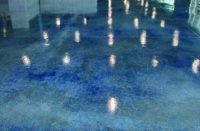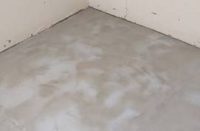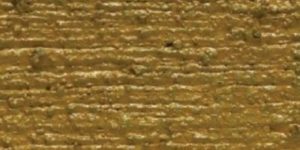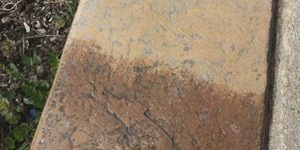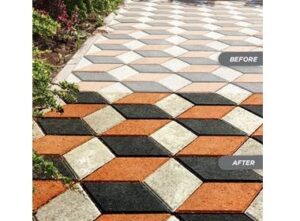One of the most common questions I get asked is, “What is the best sealer?” My answer to this is, “It depends.” While this may seem like I’m dodging the question, it really gets to the heart of the issue. Selecting a finish solely based on how good it is said to be can often lead to undesirable results.
Most decorative concrete projects involve selecting a sealer, and with concrete countertops this has been and continues to be a challenge for many. I believe what makes the task difficult for some is that they’re looking for an answer before they ask the right questions.
Finding the right sealer involves first figuring out what you want and what environment it will be used in. Not every sealer looks or performs the same, so the path to selecting the right finish begins with setting criteria by which each different sealer choice is evaluated. Common criteria include: look, feel, sheen, protection, abrasion resistance, color enhancement, durability, maintenance, cost, application difficulty and environmental effects.
There are two paths that can be taken when it comes to sealing concrete. The term “sealing” is used loosely in our industry and it’s often meant to describe the process as well as the product used to protect concrete. Sealing in this sense includes both penetrating treatments and topical coatings. This article will delve into one of those two options, penetrating treatments, and how they work.
For those who want a “natural” concrete finish, one that looks and feels like bare concrete, the choices are limited to those products and methods that preserve or imitate bare concrete’s character. Penetrating treatments do that.
Penetrating treatments include repellants and hardeners. Both are products that penetrate into the concrete and change it, either making it less porous or altering its surface tension characteristics.
Repellants, which include products that “seal” stone and tile, include silanes, siloxanes and other fluoropolymers. These products effectively change the surface tension characteristics of the concrete, causing liquids to bead up on the surface rather than wetting out the concrete and being drawn down into the capillary pores. Most repellants cause water and other aqueous liquids to bead — these are called hydrophobic. Others work on oils and are called oleophobic.
Silane is a very tiny molecule that penetrates deeply. It repels both water and oil. Siloxane, on the other hand, is a very large molecule that stays near the surface — it repels only water. Fluoropolymers also cause beading action by using different chemistry.
Repellants come in two varieties: the natural or invisible version, which does not change the appearance of the dry concrete surface, and the color-enhancing version, which wets out the surface to pop the color of the concrete.
Many repellants used as stone and tile sealers are persistent but not permanent, meaning they must be periodically reapplied. Either they wear off, are washed off or migrate deeper into the concrete. The interval before reapplication varies and can range from three months to a year or more.
Hardeners, on the other hand, are permanent. These are silicate-based materials that react with and change the concrete. Their primary purpose is to plug the open pores and capillaries in the concrete. Common hardeners include sodium, potassium and lithium silicates, potassium siliconates, and newer colloidal silicates. Of these, lithium silicate offers the greatest reactivity and control over efflorescence and alkali-silica reaction. Hardeners are often referred to as “reactive sealers” in the concrete countertop industry.
All hardeners do basically the same thing. How they do it, and the degree and the speed at which it happens, varies depending upon the chemistry. Essentially hardeners react with the calcium hydroxide in the concrete to form more calcium silicate hydrate (CSH) crystals, the desirable products of cement hydration. The CSH helps plug open pores and makes the cement paste harder. This last point is what makes hardeners an integral part of concrete polishing. Aggregates in concrete are generally much harder than the surrounding cement paste, so densifying helps make the softer cement paste harder so it too can be polished to a shine.
Hardeners take time to react, and the degree of reaction and the resulting effectiveness depends not only on the chemistry of the hardener but also upon the concrete’s age and makeup. If a hardener is applied to very young concrete or no time is given for the reaction to occur, then the hardener won’t do very much to improve the concrete. On the other hand, densifying older concrete and giving it enough time to work can yield good results.
The benefits of penetrating treatments are as follows: Because these products soak into the concrete, application is very simple and requires little skill or practice. Since they don’t sit on the concrete surface, the “natural” look is preserved. Also, resistance to abrasion, wear and scratches is high, provided the concrete is sound.
Penetrating treatments do have downsides, and those choosing them solely for how they preserve the look and feel of concrete have learned the hard way that just because they will make water bead up doesn’t mean they protect against staining and etching. Because the surface of the concrete is still bare concrete, and any spilled liquid is still touching the concrete, the Achilles heel for all penetrating treatments is acid. Splash lemon juice, vinegar or another acidic liquid onto treated concrete and inevitably etching will occur. Repellants and hardener don’t stop acid attack, and it’s my experience this is one of the most overlooked downsides that cost many concrete countertop makers a lot of money, time and headaches.
Does this make penetrating sealers a poor choice overall? No, but in my opinion they are a poor choice for a kitchen countertop, where food stains, acids, oil and water are commonly left to dwell on the countertop surface. However, for other situations where such an aggressive environment doesn’t exist, penetrating treatments may be a great choice.
Ultimately the sealer’s characteristics, both positive and negative, must be weighed against the concrete, its environment, the rigors it will undergo and the aesthetic standards to which it will be held.
The other path to protection lies in topical coatings. Unlike penetrating treatments, topical sealers rely on the coating’s properties to provide all of the protection. The concrete is never exposed to stains or acid attack because nothing actually touches the concrete. Topicals offer more choices and considerations than there are with penetrating treatments, and I believe it’s because of this that so many people are confused, frustrated and bewildered. In my next article, I will clear up the confusion.
